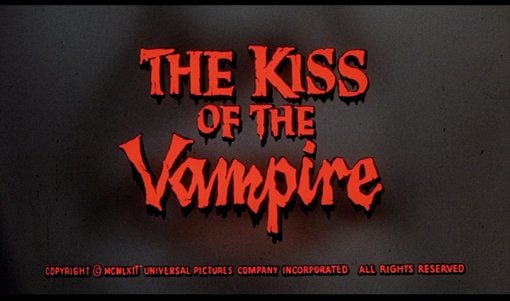

After
the big box office successes of their gothic horror titles, Hammer tried
to expand their X-rated horror department into the Spanish set Curse of the Werewolf (1961), and later the period romance Phantom of the Opera
(1962), which was heavily toned down in the horror to achieve an A
rating. The relative failures of these films at the box-office had lead
to the studio almost closing down at the end of production in
1961, their American backers concerned that Hammer were over-reaching
themselves and not sticking to their popular (and money making)
formula. After re-establishing themselves with some quickly filmed psychological thrillers,
including Paranoiac (1963), the studio tried to recapture some of their earlier successes with an all out gothic horror film...
A
funeral is taking place in a remote village somewhere in Europe, the
priest is interrupted in his incantations by the drunken Dr. Zimmer who
throws a spade into the coffin, to be met by a scream and flow of fresh
blood from within. Later, a honeymooning English couple Marianne and
Gerald Harcourt are driving through the district, but become lost in
the maze of roads and run out of petrol - finding refuge in the small
town hotel, they are put off by the mysterious and desolate atmosphere
of the building and the staff. Unexpectedly they find themselves
invited to dine at the house
of Dr. Ravna who lives in the castle overlooking the town - but the
doctor is more than he seems, and has designs on Marianne that only Dr.
Zimmer can help to prevent...


Presumably
due to the film's low budget (and with their stalwart horror star Peter
Cushing on a short lived return to television acting), Kiss of the Vampire
is cast with an interesting mix of character actors and theatrical
performers, with strong performances all round. Clifford Evans returns
from the co-leading role in Curse of the Werewolf (1961) to play Dr. Zimmer, while Edward de Souza reprises his heroic lead from Phantom of the Opera
(1962) as Gerald Harcourt. Noel Williams and Barry Warren (as Dr. Ravna
and his son Karl) make their first appearances for Hammer, and would
both go on to star in two more productions for the studio.
Although conceived as a simple gothic horror film Kiss of the Vampire
overcomes its low budget and lack of big name actors thanks to an
original script and strong production with good performances all round.
Certainly recommended to all Hammer and gothic horror fans.

| Anyone famous in it? | A variety of familiar faces, but no major names. |
| Directed by anyone interesting? | Don Sharp - a solid, first-time Hammer director who later directed Rasputin: The Mad Monk (1966). |
| Is it scary? | A couple of brief scenes might raise a scare. |
| Any violence? | There is some blood flow, although it is the standard Hammer film's bright blood. |
| Any sex? | No |
| Who is it for? |
All Hammer and gothic horror fans should check this one out. |
| Good soundtrack? | James Bernard gives a standard orchestral score with a couple of Dracula cues. |
| Visuals | Original Aspect Ratio - 1.85:1. Anamorphically Enhanced. Colour The picture quality is good, with strong colours and detail some very light grain throughout. |
| Audio | Original English mono - Dolby Digital - sounds great, no hiss. |
| Subtitles | English HOH, Spanish and French. |
| Run Time | Main Feature: 1hr 28m 12s |
| Extras | None. |
| Availability | Only available as part of the Hammer Horror Series boxset. |
| Region | Region 1 - NTSC |
| Other regions? | There was a release in the US from Image Entertainment, now out-of-print, this new release is much better. |
| Cuts? | Believed to be fully uncut. Print used is English language. When shown on US television, the print was heavily cut and padded out with additionaly shot scenes for a two hour run-time. The film is presented here in its original theatrical version. |